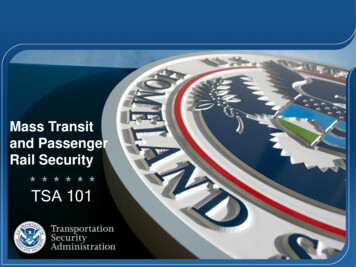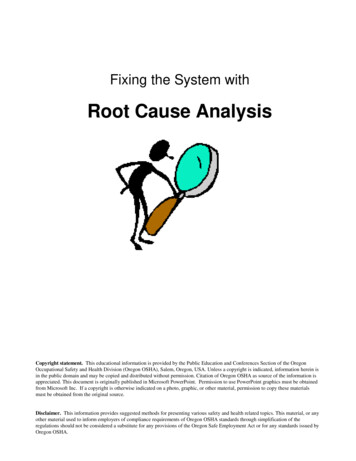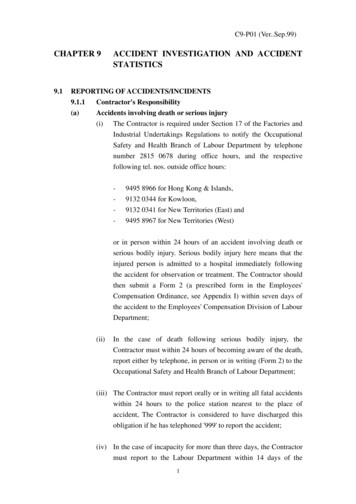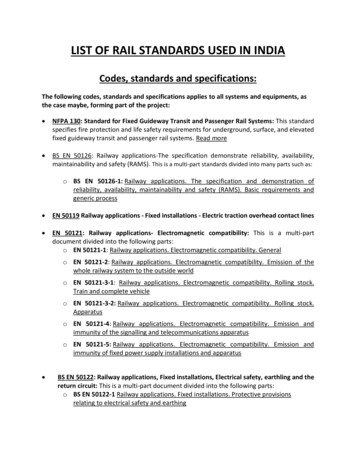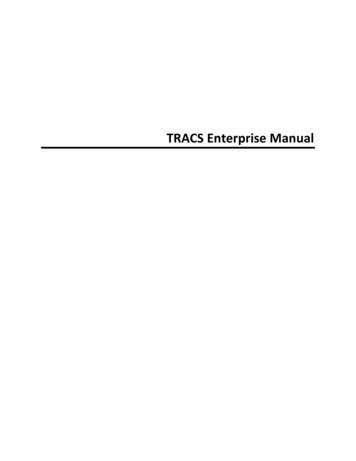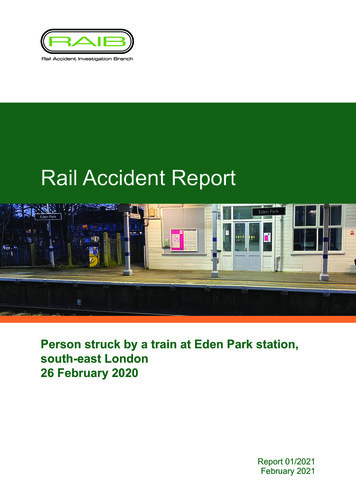
Transcription
Rail Accident ReportPerson struck by a train at Eden Park station,south-east London26 February 2020Report 01/2021February 2021
This investigation was carried out in accordance with:l theRailway Safety Directive 2004/49/ECl the Railways and Transport Safety Act 2003l the Railways (Accident Investigation and Reporting) Regulations 2005. Crown copyright 2021You may re-use this document/publication (not including departmental or agency logos) free of chargein any format or medium. You must re-use it accurately and not in a misleading context. The materialmust be acknowledged as Crown copyright and you must give the title of the source publication.Where we have identified any third party copyright material you will need to obtain permission from thecopyright holders concerned. This document/publication is also available at www.gov.uk/raib.Any enquiries about this publication should be sent to:RAIBThe WharfStores RoadDerby UKDE21 4BAEmail: enquiries@raib.gov.ukTelephone: 01332 253300Website: www.gov.uk/raibThis report is published by the Rail Accident Investigation Branch, Department for Transport.
PrefacePrefaceThe purpose of a Rail Accident Investigation Branch (RAIB) investigation is toimprove railway safety by preventing future railway accidents or by mitigating theirconsequences. It is not the purpose of such an investigation to establish blame orliability. Accordingly, it is inappropriate that RAIB reports should be used to assignfault or blame, or determine liability, since neither the investigation nor the reportingprocess has been undertaken for that purpose.RAIB’s findings are based on its own evaluation of the evidence that was available atthe time of the investigation and are intended to explain what happened, and why, in afair and unbiased manner.Where RAIB has described a factor as being linked to cause and the term isunqualified, this means that RAIB has satisfied itself that the evidence supports boththe presence of the factor and its direct relevance to the causation of the accident orincident that is being investigated. However, where RAIB is less confident about theexistence of a factor, or its role in the causation of the accident or incident, RAIB willqualify its findings by use of words such as ‘probable’ or ‘possible’, as appropriate.Where there is more than one potential explanation RAIB may describe one factor asbeing ‘more’ or ‘less’ likely than the other.In some cases factors are described as ‘underlying’. Such factors are also relevantto the causation of the accident or incident but are associated with the underlyingmanagement arrangements or organisational issues (such as working culture).Where necessary, words such as ‘probable’ or ‘possible’ can also be used to qualify‘underlying factor’.Use of the word ‘probable’ means that, although it is considered highly likely that thefactor applied, some small element of uncertainty remains. Use of the word ‘possible’means that, although there is some evidence that supports this factor, there remains amore significant degree of uncertainty.An ‘observation’ is a safety issue discovered as part of the investigation that is notconsidered to be causal or underlying to the accident or incident being investigated,but does deserve scrutiny because of a perceived potential for safety learning.The above terms are intended to assist readers’ interpretation of the report, and toprovide suitable explanations where uncertainty remains. The report should thereforebe interpreted as the view of RAIB, expressed with the sole purpose of improvingrailway safety.Any information about casualties is based on figures provided to RAIB from varioussources. Considerations of personal privacy may mean that not all of the actual effectsof the event are recorded in the report. RAIB recognises that sudden unexpectedevents can have both short- and long-term consequences for the physical and/or mental health of people who were involved, both directly and indirectly, in whathappened.RAIB’s investigation (including its scope, methods, conclusions and recommendations)is independent of any inquest or fatal accident inquiry, and all other investigations,including those carried out by the safety authority, police or railway industry.Report 01/2021Eden ParkFebruary 2021
This page is intentionally left blankReport 01/2021Eden Park4February 2021
Person struck by a train at Eden Park station,south-east London, 26 February 2020ContentsPreface 3Summary 7Introduction 8Definitions 8The accident 9Summary of the accident 9Context 9The sequence of events 12Analysis 14Identification of the immediate cause 14Identification of causal factors 14Risk management 21Factors associated with the emergency service response 28Observations 34Summary of conclusions 37Immediate cause 37Causal factors 37Risk management 37Factors associated with the emergency service response 37Additional observations 37Actions reported as already taken or in progress relevant to this report 38Previous RAIB recommendations relevant to this investigation 39Recommendations that are currently being implemented 39Recommendations that are reported to have been implemented 40Background to RAIB’s Recommendations 1 and 2 41Recommendations 42Appendices 45Appendix A - Glossary of abbreviations and acronyms 45Appendix B - Investigation details Report 01/2021Eden Park465February 2021
This page is intentionally left blankReport 01/2021Eden Park6February 2021
At around 19:05 hrs on Wednesday 26 February 2020, a passenger train struck andfatally injured a person who had just fallen from platform 1 of Eden Park station.The person, who had impaired vision, moved near to, and fell from, the platform edgeprobably because his visual impairment meant he was unaware that he was close tothis edge. The platform edge was not fitted with markings intended to assist visuallyimpaired people.Following the accident, emergency services staff were unable to determine whetherthe third rail traction power supply had been turned off until a member of Network Railstaff arrived on-scene. This resulted in a delay of over 12 minutes between LondonAmbulance Service staff arriving at the scene and accessing the track to providemedical care.The combined effect of DfT, ORR, RSSB, Network Rail and Southeastern Railwayguidance and processes meant that safety-based justifications for platform edgemarkings (including tactile surfaces) to aid visually impaired people, were not alwayseffectively considered by the railway industry.The report makes six recommendations. The first and second are addressed to DfTand Network Rail, firstly to seek improvements in the processes that govern whentactile surfaces at the edge of station platforms should be installed, and secondlyto develop a plan for installing tactile surfaces at higher priority locations in a timelymanner across the railway network. The third is addressed to the Rail Delivery Groupto develop means of reducing the risk to visually impaired people using stationplatforms where tactile surfaces have not yet been installed. The fourth is addressedto ORR and seeks improvements in the information made publicly available to helpvisually impaired people to decide whether it is safe to travel. The fifth is addressed toRSSB, to develop processes to ensure that the rail industry has sufficient information,guidance and decision-support tools to fully address the safety risks associated withdisabled people using the railway.A sixth recommendation is addressed to the British Transport Police, National FireChiefs Council, Association of Ambulance Chief Executives, London Fire Brigade,London Ambulance Service and Network Rail to improve the processes associatedwith emergency services staff responding to incidents on the national rail network.Report 01/2021Eden Park7February 2021SummarySummary
IntroductionIntroductionDefinitions1Metric units are used in this report, except when it is normal railway practice togive speeds and locations in imperial units. Where appropriate the equivalentmetric value is also given.2The report contains abbreviations and acronyms. These are explained inAppendix A. Sources of evidence used in the investigation are listed in AppendixB.Report 01/2021Eden Park8February 2021
The accidentThe accidentSummary of the accident3At around 19:05 hrs on Wednesday 26 February 2020, a train struck and fatallyinjured a person who had just fallen from platform 1 of Eden Park station, insouth-east London. The train was stopping at Eden Park station and travelling ataround 25 mph (40 km/h) when the person was struck.ContextLocation4Eden Park station is approximately 3.2 miles (5.2 km) north-east of Croydontown centre (figure 1). It is 12.4 miles (20 km) from London Charing Cross on theMid- Kent line, which terminates at Hayes.Location of accident Crown Copyright. All rights reserved. Department for Transport 100039241. RAIB 2021Figure 1: Extract from Ordnance Survey map showing location of accidentRail equipment involved5Eden Park station has two platforms with a subway running between them.Platform 1, which is used by trains travelling from Hayes towards London, can beaccessed via stairs from the subway or from a ramped path leading up from thestation car park (see figure 2). The accident occurred on platform 1 which hasa left-hand curve when viewed in the London-bound direction. At the time of theaccident the station was unstaffed.Report 01/2021Eden Park9February 2021
SubwayThe accidentPlatform 21K60Platform 1PathRoadFigure 2: Schematic diagram of person’s route to platform 1 (red arrow) within Eden Park station up toaround one minute before the accident6The Mid-Kent line is electrified at 750 volts DC using the third rail (also knownas the conductor rail) system. The electric power supply is controlled from theLewisham electrical control room by an electrical control operator.Organisations involved7Southeastern Railway is the train operating company (TOC) responsible for thetrain involved in the accident, and employed the train driver. It leased Eden Parkstation from Network Rail as part of its franchise agreement. As such, it was theleasehold owner of the station and is referred to as the Station Facility Owner andStation Facility Operator in other railway documentation. It is referred to as thestation operator in this report.8Network Rail is the freehold owner of Eden Park station, including its buildings,platforms and station furniture. It employed the signaller, the electrical controloperator and the manager who acted as Rail Incident Officer (RIO).9Both Network Rail and Southeastern Railway had safety and maintenanceresponsibilities relating to Eden Park station. These are discussed further atparagraph 56.10 British Transport Police (BTP) is the national police force for British railways(including mainline railways, the London Underground, and some light rail andtram systems). London Ambulance Service (LAS) and London Fire Brigade (LFB)provide, respectively, emergency ambulance and emergency fire and rescueservices in the Greater London region. All three organisations were involved in theemergency response to the accident (see paragraph 84).11 All the organisations involved freely co-operated with the investigation.Report 01/2021Eden Park10February 2021
12 The train, reporting number 1K60,1 that struck the person was the 19:00 hrsHayes to London Charing Cross service. It was a 10-car train formed of class 465and 466 electric multiple units and was fitted with forward facing CCTV, whichwas not working at the time of the accident. The train was fitted with an on-traindata recorder (OTDR) and information from this was available.13 Southeastern Railway found no defects in the train’s braking system followingthe accident. While it did not formally measure the sound pressure levels of thewarning horn following the accident, it confirmed that the horn was functioningnormally. There is no evidence that the condition or operation of the traincontributed to this accident.14 A second train stopped at platform 2 of Eden Park station shortly after theaccident occurred. This was train reporting number 1V62, the 18:27 hrs LondonCharing Cross to Hayes service, and was an 8-car train, also formed of class 465electric multiple units. It was not fitted with forward facing CCTV.People involved15 The person struck by the train, Cleveland Gervais, was 53 years old and regularlyused public transport. He was visually impaired and registered as partiallysighted. He was blind (light sensitivity only) in his right eye and had reducedacuity and tunnel vision in his left eye. Witness evidence suggests that, as withmany visually impaired people, he had diminished light adaptation, where the timetaken for vision to recover from a transition from dark to light, or from light to dark,is greater than for someone who is not affected.16 Cleveland Gervais was also mobility impaired and used a walking aid. He hadarranged for the walking aid to be painted white to help those around him identifyhim as visually impaired. Like most2 visually impaired people travelling on therailway network, he did not use a cane to find and avoid obstacles (known as a‘guide cane’ or ‘long cane’). Evidence indicates (see paragraph 109) that he wasnot aware of staff assistance or alternative travel arrangements offered by stationoperators for disabled passengers using their services.External circumstances17 The accident occurred after dark. A site visit by RAIB on the day after the accidentat about the same time as the accident found that there was a satisfactory level oflighting on both platforms.18 Local weather records indicate that the temperature was around 5 C, there wasa light breeze and it was not raining during the accident. Station CCTV evidenceshowed there was no standing water or ice on the platform in the area where theaccident occurred.19 No unusual lights or noises were noted by a witness who was on the platform.Other station sounds, such as the station announcements and arrival of 1V62 atplatform 2, are discussed at paragraph 35.1An alphanumeric code, known as the ‘train reporting number’, is allocated to every train operating on NetworkRail infrastructure.2Transport Research Laboratory (TRL) research project 082 ‘Accidents involving visually impaired people usingpublic transport or walking’, published in 1995.Report 01/2021Eden Park11February 2021The accidentTrains involved
The sequence of eventsThe sequence of eventsEvents preceding the accident20 The person entered the station at around 18:51 hrs (about 14 minutes before theaccident). Witness evidence indicates that he intended to catch the train (1K60)that was due at Eden Park station at 19:05 hrs, and travel to Waterloo Eaststation. From there he was intending to walk to Waterloo (Main) station and catchanother train to his destination.21 The person used the subway between the platforms, climbed the stairs up toplatform 1 and walked along the platform (see figure 2). From around 12 minutesbefore the accident, he was standing near the top of the ramped entrance toplatform 1.Events during the accident22 Around 56 seconds before the accident, a station announcement began,signifying the impending arrival of train 1K60 at platform 1. Eight seconds laterthe person began to move towards the edge of the platform, and subsequentlystopped on the yellow line that indicates a safe distance to stand away from theplatform edge, and looked up and down the track. He then stepped back aroundhalf a metre behind the yellow line.23 Around 31 seconds before the accident, the announcement about train 1K60ended and an announcement relating to the impending arrival of train 1V62 atplatform 2 began.24 Nine seconds before the accident, the person started to move towards theplatform edge (see figure 3, positions 1 and 2). He turned left (facing up the trackwith his back towards train 1K60) and continued to move closer to the edge (seefigure 3, positions 2 and 3). Six seconds later his right foot reached the white line(at the platform edge) as he walked along the platform at an acute angle to theedge (see figure 3, positions 3 and 4). He fell onto the track at the same momentas the driver of train 1K60 began to sound the train’s warning horn (see figure 3,position 4), and one second later the train struck the person.Events following the accident25 Around 20 seconds after the accident train 1V62 arrived at platform 2. StationCCTV evidence indicates that it had neither stopped nor opened its doors at thetime the person was struck by 1K60.26 The subsequent response by the emergency services is considered in paragraphs84 to 107.Report 01/2021Eden Park12February 2021
The sequence of eventsFigure 3: Schematic diagram of person’s movementsReport 01/2021Eden Park13February 2021
AnalysisAnalysisIdentification of the immediate cause27 The person fell from the platform edge as the train was arriving at theplatform.28 CCTV evidence shows that the person was struck by the train around one secondafter he fell from the edge of the platform.Identification of causal factors29 The most likely explanation for this accident is that the person moved near to, andfell from, the platform edge, because he was unaware that he was close to theedge (paragraph 30). It is possible that the absence of tactile surface markingsintended to assist visually impaired people was also a factor (paragraph 36).These factors are now considered in turn.The actions of the person30 The person moved near to, and fell from, the platform edge, probablybecause he was unaware that he was close to this edge.31 RAIB has considered four possible reasons why the person moved near to, andfell from, the platform edge. These were:a. because he was unaware he was close to it (probable)b. because of a loss of balance, slip or trip whilst on the platform (unlikely)c. because of impaired judgement due to drugs, alcohol or a sudden medicalepisode (unlikely)d. because he was trying to board 1K60 (unlikely).32 Considering the first possibility, it is unclear when or why the person lostawareness of his position in relation to the platform edge before movingdangerously close to it. However, three seconds before the accident he waswalking very near the platform edge with the track on his right (fully blind) side,and would have had limited peripheral vision from his left eye with which to judgehis immediate position in relation to the platform edge. Additionally, in the periodbetween 38 and 9 seconds before the accident, he was looking towards an areaof relative darkness, and he then turned towards an area that was brightly lit. Hisdiminished light adaptation (see paragraph 15) would probably have meant thathis vision was further weakened at this point. It is therefore probable that he hadvery limited vision in the seconds immediately before he fell, and was unable toaccurately judge his position relative to the platform edge.Report 01/2021Eden Park14February 2021
a. His movements in the seconds before he lost his footing were not consistentwith this. Rather, he can be seen to be walking down the platform with asteady gait but at an acute angle to the platform edge. Just before he fell, heappeared to be about to put his right foot just off the edge of the platform andinto the empty space above the track.b. No trip or slip hazards were identified near where the person was walking.c. The person can be seen to be walking steadily (without using his walkingaid) up the stairs between the subway and the platform, and in a consistentdirection along the platform before the accident.34 Considering the third possibility, it is unlikely that the person fell because ofimpaired judgement due to alcohol, drugs or a sudden medical episode:a. There was no evidence identified in the post-mortem examination that mightsuggest that the person suffered a sudden medical episode immediatelybefore the accident.b. The post-mortem toxicology report recorded a blood alcohol concentration of20 mg per 100ml, well below the legal limit for driving in the UK (80 mg per100ml).c. The post-mortem toxicology report recorded a blood tetrahydrocannabinol(THC, the primary psychoactive component of cannabis) concentration of6.2 ng per ml, which was above the concentration that may be associated withimpairment (3.5 ng per mI). However, the report also noted that for a regularuser of cannabis, the concentrations of THC at post-mortem will be higherthan at the time of death, and that concentrations associated with recreationalcannabis use range up to over forty times higher (267 ng per ml) than theperson’s blood concentrations recorded at post-mortem.d. No other prescription or non-prescription drugs were detected by thepost- mortem toxicology screening.e. The person’s movements around the station and on platform 1 before theaccident were inconsistent with someone suffering from impaired judgement(paragraph 33).35 Considering the fourth possibility, following the accident it was reported in themedia that witnesses had stated that the person had become confused afterhearing a train arriving on a different platform. The audible cues associated witha train arriving at another platform, and its doors opening, can be similar to thoseassociated with a train arriving at the platform a person is standing on. Becauseof this, visually impaired people may attempt to board a train that has not yetarrived because they have become aware of a train arriving at a different platform.However, it is unlikely that the person fell because he was trying to board train1K60 for the following reasons:a. The person’s movements on the platform are not consistent with someoneattempting to board a train (paragraph 33).Report 01/2021Eden Park15February 2021Analysis33 Considering the second possibility, RAIB cannot fully discount a loss of balanceassociated with the person’s impaired mobility. However, it is unlikely that he felldue to a loss of balance, slip or trip because:
Analysisb. Although train 1V62 was approaching platform 2 at the same time as train1K60 was arriving at platform 1, it had neither stopped nor opened its doors atthe time when the person fell.c. The station announcements for both trains were made in the correctsequential order.The platform edge36 The platform edge was not fitted with tactile surface markings intended toassist visually impaired people. This is a possible causal factor.37 The platforms at Eden Park station were not provided with tactile surfaces.Tactile surfaces for station platformsHistory and standards38 When independently moving around in the general pedestrian environment,visually impaired people make use of non-visual cues, such as tactile informationunderfoot.3 Designers of pedestrian environments can make use of this byinstalling tactile surfaces to convey important information to visually impairedpeople about their environment, such as a hazard warning, directional guidanceor to indicate the presence of an amenity. Transport Research Laboratory (TRL)research4 has shown that visually impaired people are able to reliably distinguishbetween different tactile surfaces and can remember their associated meanings.39 In 19865 the Department of Transport (now the Department for Transport (DfT))introduced guidance on the use of tactile surfaces to help visually impaired peoplelocate controlled road crossings. This guidance was subsequently expanded forother uses in 19986 (referred to in this report as the ‘DfT guidance’). This includedguidance on the use of tactile surfaces at mainline stations to provide a warningto visually impaired people that they are approaching the edge of a stationplatform.40 The DfT guidance requires tactile surfaces for use at the edge of station platforms(referred to as tactile surfaces in the remainder of this report) to be made up of400 mm squares, each having rows of flat-topped domes (blisters, 22.5 mm outerdiameter and 5 mm in height). The blisters are spaced at intervals of 66.5 mmand each row is off-set so a blister in the second row will appear halfway betweenblisters in the first row (figure 4). The guidance required the whole surface to bemore than 500 mm from the platform edge, and of a colour that would provide agood contrast with the platform surface.3Department of the Environment, Transport and the Regions (now DfT) ‘Guidance on the use of tactile pavingsurfaces’, published 1998.4TRL research project 179 ‘Trials on platform edge tactile surfaces’, published 1996.5Department of Transport (now DfT) Disability Unit circular 1/86, ‘Textured footway surfaces at pedestriancrossings’, published 1986.6See footnote 3.Report 01/2021Eden Park16February 2021
Analysis400This side towards the platform edgeDirection of approachto platform edge66.522.5400155 0.5Figure 4: Profile and plan view of tactile surfaces atmainline stations41 Prior to May 2018, some mainline railway platforms had tactile surfaces paintedyellow and installed 760 mm from the platform edge (see figure 5). RSSBresearch7 recommended that this should become standard practice, wherepossible, to provide a high contrast between the platform surface and the track.The research noted that this contrast is important for both visually impairedpeople and the general population. Rail Industry Standard RIS-3703-TOM‘Passenger Train Dispatch and Platform Safety Measures’ was updated (issue 4)to reflect this recommendation in March 2020.Effectiveness of tactile surfaces42 RSSB’s safety risk model (SRM) v8.5.0.2, dated March 2018, expresses safetyrisk in terms of predicted fatalities and weighted injuries8 (FWI). SRM risk datais used by the railway industry to support safety-related decision making. SRMestimates the risk to passengers at the platform-train interface (PTI) to be12.0 FWI per year, which represents around half of the total passenger risk on themainline railway network.7RSSB’s research project T1118 ‘Optimising the design and position of platform markings designed to keep peopleaway from the platform edge’, published May 2018.8Defined by RSSB as the aggregate amount of safety harm. One FWI is equivalent to one fatality, 10 major injuriesor 200 minor injuries or shock/trauma events requiring hospital admission, or 1000 minor injuries or shock/traumaevents not requiring hospital admission.Report 01/2021Eden Park17February 2021
AnalysisFigure 5: Platforms at Three Bridges station (left) and platform 1 at Eden Park station (right). Left imagecourtesy of RSSB.43 RAIB has identified that the installation of tactile surfaces would affect the twohazard categories which underpin significant proportions of the overall PTI riskestimate:a. 4.7 FWI per year associated with people falling from or getting too close to theplatform edgeb. 6.6 FWI per year associated with people having accidents when boarding andalighting trains.44 The extent to which tactile surfaces will affect the overall PTI risk will depend ona number of factors, such as the proportion of visually impaired people involvedin accidents at the PTI, and the effectiveness of tactile surfaces in preventingaccidents.45 Research has shown that visually impaired people are exposed to significantlyhigher levels of individual risk than the general public at mainline stationplatforms. This research includes:a. An analysis of Safety Management Intelligence System (SMIS, the nationaldatabase for recording safety-related events) data showed that visuallyimpaired people account for between 99 and 1510 percent of people who fallfrom station platforms with no train present. The data probably undervaluesthe proportion of visually impaired people affected because:i. SMIS does not systematically record, or require the person inputting theinformation to state, whether the person who has had an accident has avisual impairment.9RAIB commissioned RSSB analysis of SMIS data from 1 January 2015 to 31 December 2019.10RSSB’s research project T158 ‘The use of tactile surfaces at rail stations’, published in 2005. Includes SMIS dataanalysis from 1 January 2001 to 31 December 2003.Report 01/2021Eden Park18February 2021
b. Research11,12 in the UK and the USA has shown that the proportion of visuallyimpaired people falling from the edge of platforms without tactile surfaces ishigher than indicated in the SMIS data.46 Royal National Institute of Blind People (RNIB) research13,14 has shown that whenstandardised for age, visually impaired people are as likely to travel by train asthe general population but around twice as likely to experience restrictions inaccessing the railway system. Additionally, DfT research15 states that visuallyimpaired people are less likely to possess a driving licence and hence would begenerally more reliant upon public transport. As such, the proportion of visuallyimpaired people in the UK population can be used as an approximation for theproportion of railway users who are visually impaired. Royal National Institute ofBlind People (RNIB) documentation16 states that 360,000 people (0.5 percentof the total UK population17) are registered as either blind or partially sighted,and estimates there are currently around two million people (3 percent of UKpopulation) living with sight loss which is severe enough to have a significantimpact on their daily lives. Since SMIS data indicates that between 9 and 15percent of people falling from platforms are visually impaired, it is reasonable toconclude that an individual visually impaired person is, on average, significantlymore likely to fall off the platform edge than an individual in the general population.47 The SMIS data does not indicate the presence or condition of platform markings(including tactile surfaces) in each case, and this makes it impossible to judge theeffectiveness of tactile surfaces based on this data alone. However, research hasshown that there is robust evidence that tactile surfaces provide a critical safetybenefit for visually impaired people.
injured a person who had just fallen from platform 1 of Eden Park station, in south-east London. The train was stopping at Eden Park station and travelling at around 25 mph (40 km/h) when the person was struck. Context Location 4 Eden Park station is approximately 3.2 miles (5.2 km) north
